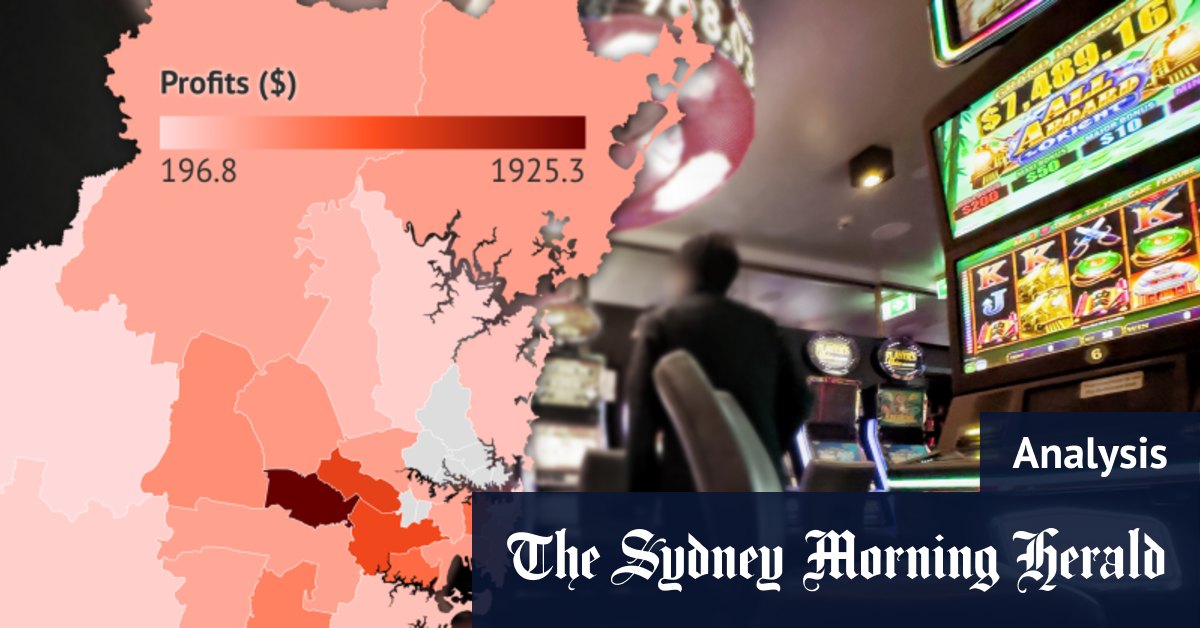
Poker machine use in NSW has bounced back strongly after the disruptions of COVID-19, with profits from gaming machines at clubs and pubs hitting a record $3.8 billion in the first half of 2022.
During the first six months of the year electronic gaming machine profits, which equate to player losses, were almost double that in the five months to November 2021, figures published by NSW Liquor & Gaming show. (Figures for December 2021 were not included in biannual reporting.)
But an investigation by the NSW Crime Commission into money laundering via poker machines, released last month, has triggered fresh calls for poker machine reforms. It found billions of dollars of annual electronic gaming machine turnover was probably “the proceeds of crime”. The industry is also being pressured to provide more effective protections for problem gamblers.
This month Premier Dominic Perrottet committed to mandatory cashless gaming cards in NSW clubs and pubs, although he has not yet outlined details of the plan or a timeline for implementation.
Here are six charts that show the scale of poker machine use in NSW.
Turnover and losses
The NSW Crime Commission says electronic gaming machine turnover at hotels and clubs was about $95 billion in 2020-21. That’s equivalent to more than a quarter of all household consumption expenditure in NSW during that financial year. The vast sums of cash flowing through poker machines in pubs and clubs makes NSW the “gambling capital of Australia”, the commission said.
Turnover figures measure the value of all bets on gaming machines, including bets made using credits won in the course of play, and is a much larger total than player losses. ClubsNSW estimates around 90 per cent of poker machine turnover in NSW is returned to gamblers as prizes.
Poker machine profits declined in 2020 and 2021 because pandemic health orders prevented patrons from attending clubs and pubs for significant periods. But player losses surged to an all-time high during the official six-monthly reporting period in the half of 2022, perhaps reflecting pent-up demand.
The most recent NSW Gambling Prevalence Survey, which predates the COVID-19 pandemic, found median monthly spending by poker machine players in the state was $30 (the median being the midpoint).
How NSW compares
NSW was the first state to legalise poker machines in 1956 and the latest data shows there were 86,640 machines as of June 30 this year. Analysis by the Wesley Mission charity shows that is 30 per cent more machines than in Queensland and Victoria combined.
A 2017 study by the Australia Institute calculated there were 2150 people per poker machine across all countries that have gaming machines. In NSW, there were 82 people per poker machine at the time.
The average poker machine turnover per person in NSW in 2018-19 was 75 per cent higher than the national average, according to data published by the Queensland Government Statistician’s Office.
Wesley Mission recently used the same Queensland government data to estimate poker machine losses in NSW have totalled $135 billion over the past 30 years, more than double the figure in Victoria over the same period.
Revenue per poker machine
Official data shows the number of electronic gaming machines operating in clubs and pubs across NSW has fallen by 6 per cent since 2017. There are also slightly fewer gaming venues to choose from than five years ago throughout the state.
But revenue per poker machine has been on the rise. For clubs the average profit generated by each machine climbed from $28,063 in the first half of 2018 to $34,311 in the first half of 2022, Liquor & Gaming NSW data shows. For hotels the average profit per machine rose from $51,604 to $72,766 over the same period.
Across NSW each poker machine generated $44,265 in profit on average in the first half of this year. If the state’s machines make the same average profit in the second half of the year, it will equate to an average of around $88,000 per machine. That would put an average machine’s yearly profits in line with the typical yearly salary of a radiographer, public relations manager or nursing supervisor or manager.
Which areas lose most on the pokies?
The top three local government areas for poker machine losses in the first half of this year were all in south-western Sydney: Canterbury-Bankstown ($325 million) Fairfield ($313 million) and Cumberland ($217 million).
According to Liquor & Gaming NSW, there are 4741 poker machines at clubs and pubs in the Canterbury-Bankstown council area, 3831 in Fairfield and 2647 in Cumberland.
Those three councils are also home to many low-income families – the 2021 census showed Fairfield had the lowest median household income among Sydney’s 33 local government areas, while Canterbury-Bankstown was third lowest and Cumberland fourth lowest.
Those three districts also had the highest poker machine losses on a per-capita basis in the first half of this year. Fairfield LGA had the highest losses per person – $1925 each if those losses were spread across every adult resident of the district.
Pokies and state revenue
Poker machine taxes make a big contribution to the state budget. The NSW government expects to collect more than $2 billion from levies on club and hotel gaming machine activity this financial year – that’s 62 per cent of all gambling revenue.
The budget in June revised up expected revenue from poker machines in clubs and hotels by $423 million over the next four years due to the strong recovery in gaming activity in 2022 and “expectations for household disposable income”.
The Morning Edition newsletter is our guide to the day’s most important and interesting stories, analysis and insights. Sign up here.